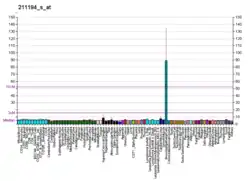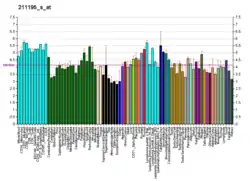P63
p63,亦作TP63,全稱腫瘤蛋白p63(tumor protein p63)或惡性轉化相關蛋白63(transformation-related protein 63),在人體內由TP63基因編碼[6][7][8][9]。p63的發現是在p53基因發現後20年。p63與p53、p73同屬一個蛋白家族,三者結構與功能都較爲相似[10]。儘管p63的發現晚於p53,但進化生物學的證據表明p63是p53蛋白家族的起源,p53、p73都是由p63蛋白演化而成[11]。
功能
p63是p53蛋白家族下的一種轉錄因子。p63-/-基因型的小鼠會出現無牙、乳腺等發育依賴間充質-上皮相互作用的器官組織及無附肢等多種發育缺陷。p63蛋白的轉錄變體主要有兩種,TAp63和ΔNp63。已證明ΔNp63擁有多種功能,包括參與皮膚發育和成體幹細胞/祖細胞的功能調控[12]。相比之下,傳統的觀點認爲TAp63的功能幾乎只侷限於參與凋亡過程。不過,近期的研究還表明TAp63參與了卵母細胞完整性的維持[13]。另一些研究還表明TAp63參與了心臟發育[14]和早衰過程[15]。
臨床意義
p63蛋白的突變可能會導致兔脣、腭裂等發育畸形[16]。p63蛋白的突變可導致以等裂兔脣爲典型特徵的EEC綜合徵(ectrodactyly-ectodermal dysplasia-cleft syndrom)[16]。此外,p63蛋白的突變也可能導致3型兔脣腭裂綜合徵(EEC3)、先天性缺指(ectrodactyly,亦稱爲裂手-腳畸形4),以及以等裂兔脣爲典型特徵的AEC綜合徵[16]。此外,ADULT綜合徵(Acro–dermato–ungual–lacrimal–tooth syndrome)、附肢-乳腺綜合徵(limb-mammary syndrome)、RHS綜合徵(Rap-Hodgkin syndrome)以及也與p63蛋白功能的異常有關。目前認爲兔脣、腭裂是同時出現還是任出現一種取決於p63的不同突變[16]近期,研究人員提出使用iPS細胞分化替代缺陷型上皮細胞治療EEC綜合徵的方法[17]。
診斷
p63的免疫組化法可以用於診斷扁平細胞癌和前列腺腺癌(最常見的一種前列腺癌)[18]。正常的前列腺腺體含有基底細胞,因而組織高表達p63,免疫染色深,而惡性轉化後的腺癌組織因缺少基底細胞,p63免疫染色呈現陰性結果[19]。p63亦可用於鑑別腺癌、小細胞癌中常見的分化程度低的癌變扁平細胞[20]。
參見
- AMACR,另一種前列腺癌的腫瘤標誌物
参考文献
- .
- GRCh38: Ensembl release 89: ENSG00000073282 - Ensembl, May 2017
- GRCm38: Ensembl release 89: ENSMUSG00000022510 - Ensembl, May 2017
- . National Center for Biotechnology Information, U.S. National Library of Medicine.
- . National Center for Biotechnology Information, U.S. National Library of Medicine.
- Yang A, Kaghad M, Wang Y, Gillett E, Fleming MD, Dötsch V, Andrews NC, Caput D, McKeon F. . Molecular Cell. Sep 1998, 2 (3): 305–16. PMID 9774969. doi:10.1016/S1097-2765(00)80275-0.
- Osada M, Ohba M, Kawahara C, Ishioka C, Kanamaru R, Katoh I, Ikawa Y, Nimura Y, Nakagawara A, Obinata M, Ikawa S. . Nature Medicine. Jul 1998, 4 (7): 839–43. PMID 9662378. doi:10.1038/nm0798-839.
- Zeng X, Zhu Y, Lu H. . Carcinogenesis. Feb 2001, 22 (2): 215–9. PMID 11181441. doi:10.1093/carcin/22.2.215.
- Tan M, Bian J, Guan K, Sun Y. . Carcinogenesis. Feb 2001, 22 (2): 295–300. PMID 11181451. doi:10.1093/carcin/22.2.295.
- Wu G, Nomoto S, Hoque MO, Dracheva T, Osada M, Lee CC, Dong SM, Guo Z, Benoit N, Cohen Y, Rechthand P, Califano J, Moon CS, Ratovitski E, Jen J, Sidransky D, Trink B. . Cancer Research. May 2003, 63 (10): 2351–7. PMID 12750249.
- Skipper M. . Nature Reviews Molecular Cell Biology. January 2007, 8 (1): 4–5. doi:10.1038/nrm2091.
- Crum CP, McKeon FD. . Annual Review of Pathology. 2010, 5: 349–71. PMID 20078223. doi:10.1146/annurev-pathol-121808-102117.
- Deutsch GB, Zielonka EM, Coutandin D, Weber TA, Schäfer B, Hannewald J, Luh LM, Durst FG, Ibrahim M, Hoffmann J, Niesen FH, Sentürk A, Kunkel H, Brutschy B, Schleiff E, Knapp S, Acker-Palmer A, Grez M, McKeon F, Dötsch V. . Cell. Feb 2011, 144 (4): 566–76. PMC 3087504
 . PMID 21335238. doi:10.1016/j.cell.2011.01.013.
. PMID 21335238. doi:10.1016/j.cell.2011.01.013. - Rouleau M, Medawar A, Hamon L, Shivtiel S, Wolchinsky Z, Zhou H, De Rosa L, Candi E, de la Forest Divonne S, Mikkola ML, van Bokhoven H, Missero C, Melino G, Pucéat M, Aberdam D. . Stem Cells. Nov 2011, 29 (11): 1672–83 [2017-11-13]. PMID 21898690. doi:10.1002/stem.723. (原始内容存档于2014-08-08).
- Su X, Paris M, Gi YJ, Tsai KY, Cho MS, Lin YL, Biernaskie JA, Sinha S, Prives C, Pevny LH, Miller FD, Flores ER. . Cell Stem Cell. Jul 2009, 5 (1): 64–75. PMC 3418222
 . PMID 19570515. doi:10.1016/j.stem.2009.04.003.
. PMID 19570515. doi:10.1016/j.stem.2009.04.003. - Dixon MJ, Marazita ML, Beaty TH, Murray JC. . Nature Reviews Genetics. Mar 2011, 12 (3): 167–78. PMC 3086810
 . PMID 21331089. doi:10.1038/nrg2933.
. PMID 21331089. doi:10.1038/nrg2933. - Shalom Feuerstein R. et al. Impaired epithelial differentiation of induced pluripotent stem cells from EEC patients is rescued by APR-246/PRIMA-1MET. P.N.A.S 2012. . [2014-12-13]. (原始内容存档于2014-12-14).
- Shiran MS, Tan GC, Sabariah AR, Rampal L, Phang KS. . The Medical Journal of Malaysia. Mar 2007, 62 (1): 36–9. PMID 17682568.
- Herawi M, Epstein JI. . The American Journal of Surgical Pathology. Jun 2007, 31 (6): 889–94. PMID 17527076. doi:10.1097/01.pas.0000213447.16526.7f.
- Zhang H, Liu J, Cagle PT, Allen TC, Laga AC, Zander DS. . Modern Pathology. Jan 2005, 18 (1): 111–8. PMID 15309021. doi:10.1038/modpathol.3800251.
- Fomenkov A, Huang YP, Topaloglu O, Brechman A, Osada M, Fomenkova T, Yuriditsky E, Trink B, Sidransky D, Ratovitski E. . The Journal of Biological Chemistry. Jun 2003, 278 (26): 23906–14. PMID 12692135. doi:10.1074/jbc.M300746200.
- Yi R, Poy MN, Stoffel M, Fuchs E. . Nature. Mar 2008, 452 (7184): 225–9. PMID 18311128. doi:10.1038/nature06642.
- Aberdam D, Candi E, Knight RA, Melino G. . Trends in Biochemical Sciences. Dec 2008, 33 (12): 583–91 [2017-11-13]. PMID 18848452. doi:10.1016/j.tibs.2008.09.002. (原始内容存档于2013-04-21).
拓展閱讀
- Little NA, Jochemsen AG. . The International Journal of Biochemistry & Cell Biology. Jan 2002, 34 (1): 6–9. PMID 11733180. doi:10.1016/S1357-2725(01)00086-3.
- van Bokhoven H, McKeon F. . Trends in Molecular Medicine. Mar 2002, 8 (3): 133–9. PMID 11879774. doi:10.1016/S1471-4914(01)02260-2.
- van Bokhoven H, Brunner HG. . American Journal of Human Genetics. Jul 2002, 71 (1): 1–13. PMC 384966
 . PMID 12037717. doi:10.1086/341450.
. PMID 12037717. doi:10.1086/341450. - Brunner HG, Hamel BC, van Bokhoven H. . American Journal of Medical Genetics. Oct 2002, 112 (3): 284–90. PMID 12357472. doi:10.1002/ajmg.10778.
- Jacobs WB, Walsh GS, Miller FD. . The Neuroscientist. Oct 2004, 10 (5): 443–55. PMID 15359011. doi:10.1177/1073858404263456.
- Zusman I. . In Vivo. 2005, 19 (3): 591–8. PMID 15875781.
- Morasso MI, Radoja N. . Birth Defects Research. Part C, Embryo Today. Sep 2005, 75 (3): 163–71. PMC 1317295
 . PMID 16187309. doi:10.1002/bdrc.20047.
. PMID 16187309. doi:10.1002/bdrc.20047. - Barbieri CE, Pietenpol JA. . Experimental Cell Research. Apr 2006, 312 (6): 695–706. PMID 16406339. doi:10.1016/j.yexcr.2005.11.028.
- Shalom-Feuerstein R, Lena AM, Zhou H, De La Forest Divonne S, Van Bokhoven H, Candi E, Melino G, Aberdam D. . Cell Death and Differentiation. May 2011, 18 (5): 887–96. PMC 3131930
 . PMID 21127502. doi:10.1038/cdd.2010.159.
. PMID 21127502. doi:10.1038/cdd.2010.159.







